Artist, Pauline Nijenhuis, has an enquiring mind. Not one to stand on the bylines and watch as 21st century production processes – including in textile art – enter an increasingly technological age, she poses some searching questions through her specially designed art projects.
Following the success of her first HAND@WORK project, Pauline has developed her second in the series to ask: what differences do we see in the ‘handwriting’ work of five embroidery artists? And how will the public evaluate the work made by hand in relation to the same work embroidered by a machine? Moreover, do people, in this era of growing digitization and robotization, still appreciate handiwork?
In her first HAND@WORK experiment in 2017 – entitled Fast Work, Time Consuming Landscape – Pauline challenged herself to work increasingly fast to see what effect it had on herself, the artist, and on the resulting artwork. Her project and its conclusions were presented in an installation at the exhibition ‘Time, Space and Architecture’ at Cityscapes Gallery in Amsterdam and also published in a book.
Pauline’s aim is not just to focus on the field of the visual arts, but to see how the ICT revolution affects our lives, our jobs and our prosperity as a whole – and on us as human beings.
Pauline studied for five years at the College of Arts Constantijn Huygens in Kampen, Netherlands and graduated from there in 1990. Originally a painter and photographer, she was first inspired to use needle and thread after moving from Rotterdam to the more rural area of Zutphen. Whilst taking part in an exhibition about the river Ijssel, she felt drawn to choose soft yarns, thin threads and the refinement of embroidery to convey the softness of the landscape.
Her awards include the Royal Grant for Fine Art (1993) and an International Arts and Crafts Design Award (2015). She has been an exhibitor across the Netherlands, and also in Canada and Belgium, since 1993, and has given numerous talks about her projects. Pauline has also contributed to many books, online publications, newspapers and magazines.
We asked Pauline about her process, from concept to creation, for her HAND@WORK embroidery project and we find out what she and four other embroiderers discovered about themselves, and their work, along the way.
Name of piece: Project HAND@WORK
Year of piece: 2019
Techniques and materials used: Each of the six pieces is 38 x 38 cm, The first five of them are embroidered by hand, the last one by machine, My design is printed on CO Linen. DMC yarn and machine yarn
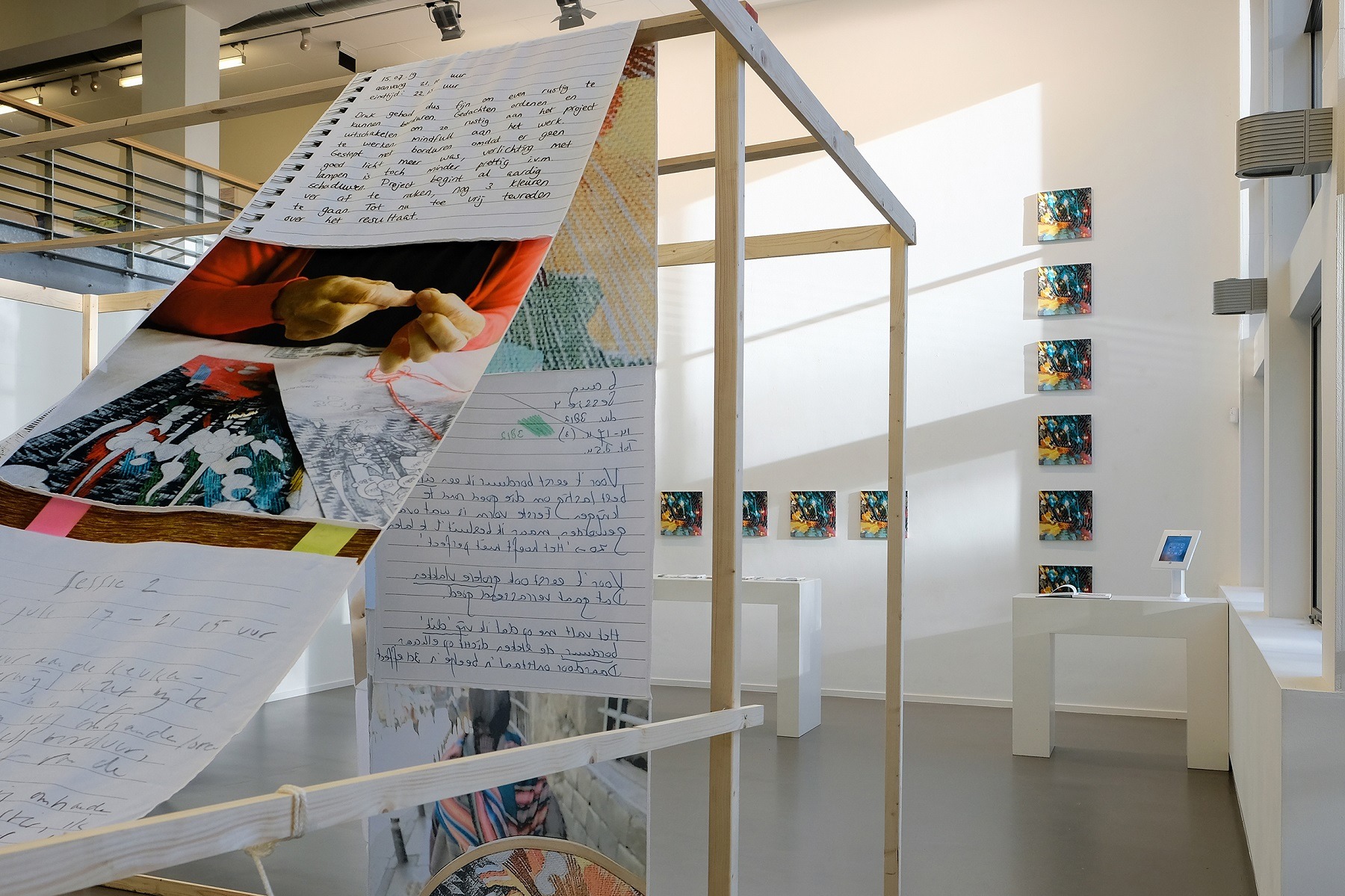

Recognising ‘handwriting‘
TextileArtist.org: How did the idea for the piece come about? What was your inspiration?
Pauline Nijenhus: My new “HAND@WORK” project is the result of new questions that I wanted answered after my earlier project “Fast Work, Time Consuming Landscape”. In this project, completed in 2017, I challenged myself to complete four versions of the same embroidery, working faster and faster with each one – even faster than a robot. I succeeded, but I had to pay the price; I experienced a lot of stress and also physical problems.
What struck me during the project is that an object made by mankind shows ‘handwriting’ – in this case in embroidery. The new HAND@WORK project focuses on the question: what makes something ‘handwriting’ and what does that add to a work of art? And what does the crafter derive from making something by hand?
This will be my new battle with the machine!
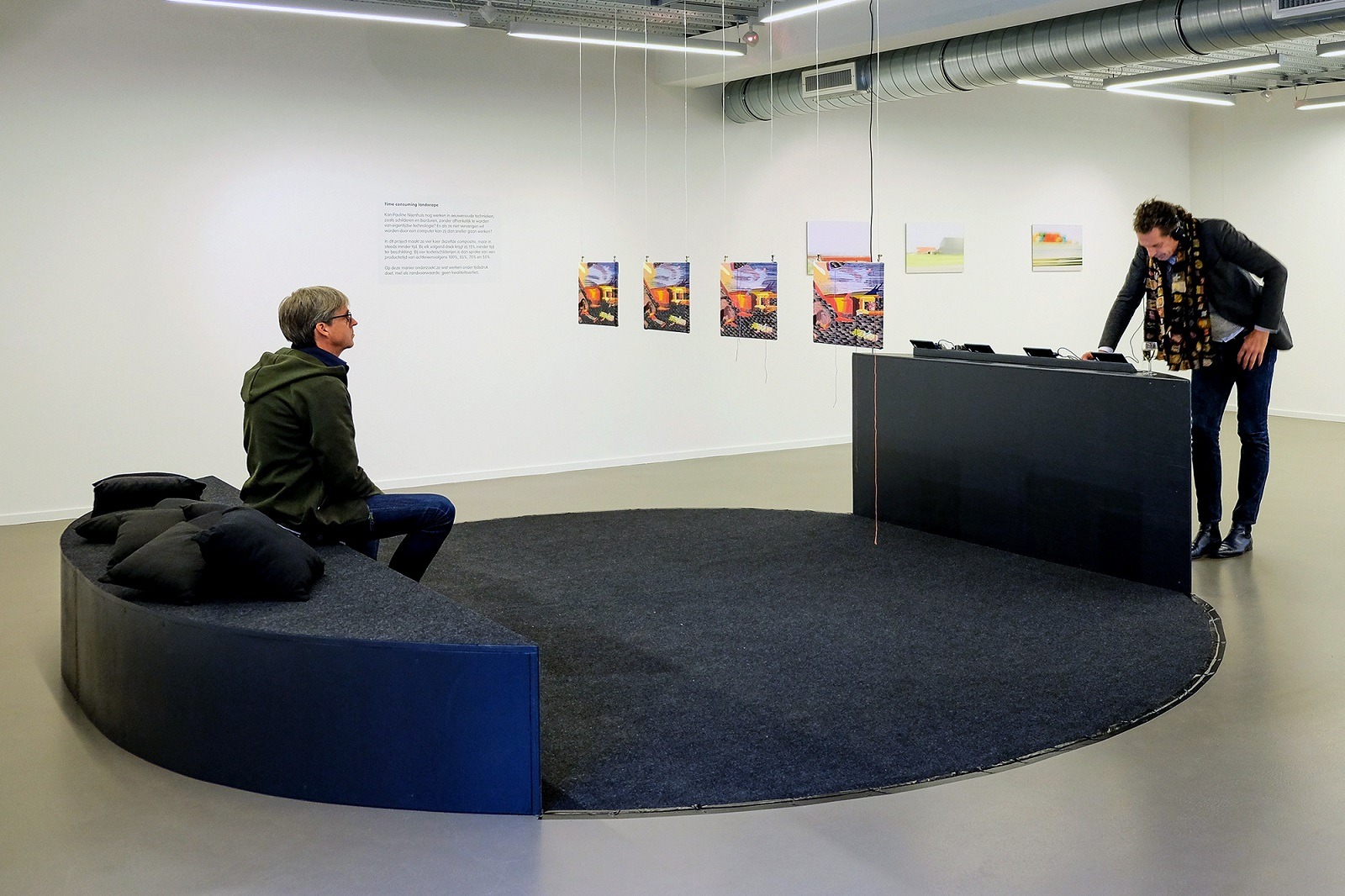
What research did you do before you started to make?
What did I need for this project?
In my previous work, it was just me competing against the embroidery machine. In this new project, I wanted more evidence that we express ‘handwriting’ in embroidery by doing it by hand. That is why I invited four other artists, all of whom specialize in embroidery, to participate. They are all artists who make inspiring works of art, using embroidery in a contemporary way.
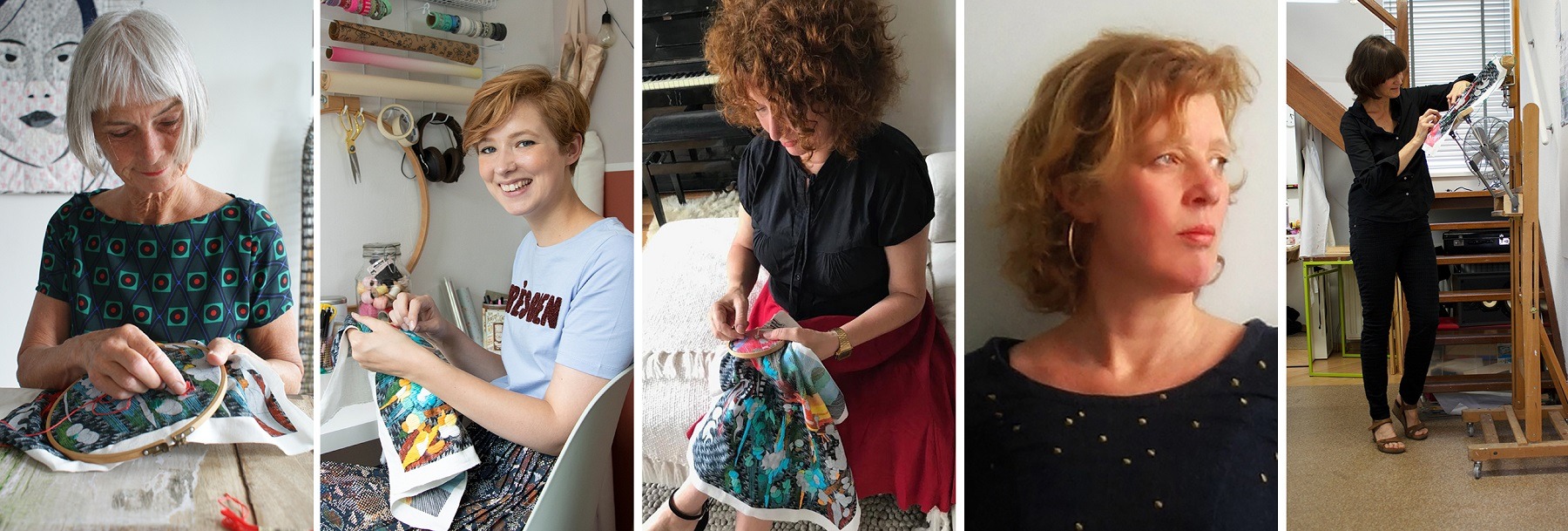
The artists who joined my team were: Marjolein Burbank, Tessa van Helden, Mique Menheere and Hinke Schreuders. By seeing how we produced our five versions of the embroidery, I hoped to discover five different ‘handwritings’ in our work. And I was looking for those little imperfections that give a human touch so that perhaps the viewer will see something of the characteristics of the artists.
Furthermore, in order to see the result of a ‘battle against the machine’ we sent a proposal for this project to the TextileLab in Tilburg who have the best embroidery machine that I know of! Frank de Wind, a specialist in the development of embroidery and laser techniques, programmed and operated the machine. And so began a new collaboration!
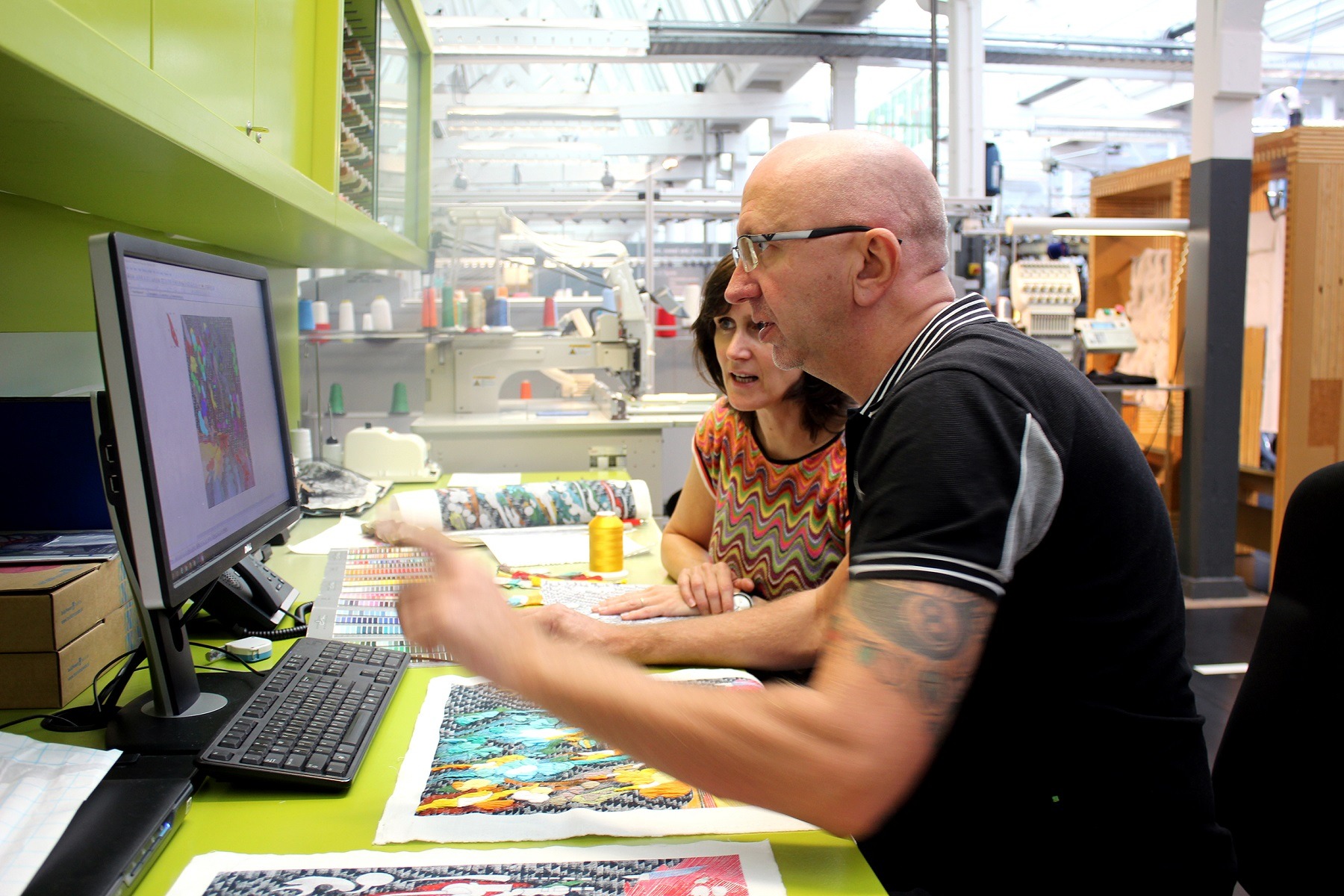
To find out what the process of embroidering brings to the artist, project coordinator Caroline van Dockum and I asked each of our selected artists to keep a logbook during their work. This, we hoped, would help us to gain an insight into what is happening in our brains during the process of embroidering. With the help of a psychologist, we also prepared a questionnaire that would go beyond the standard answers.
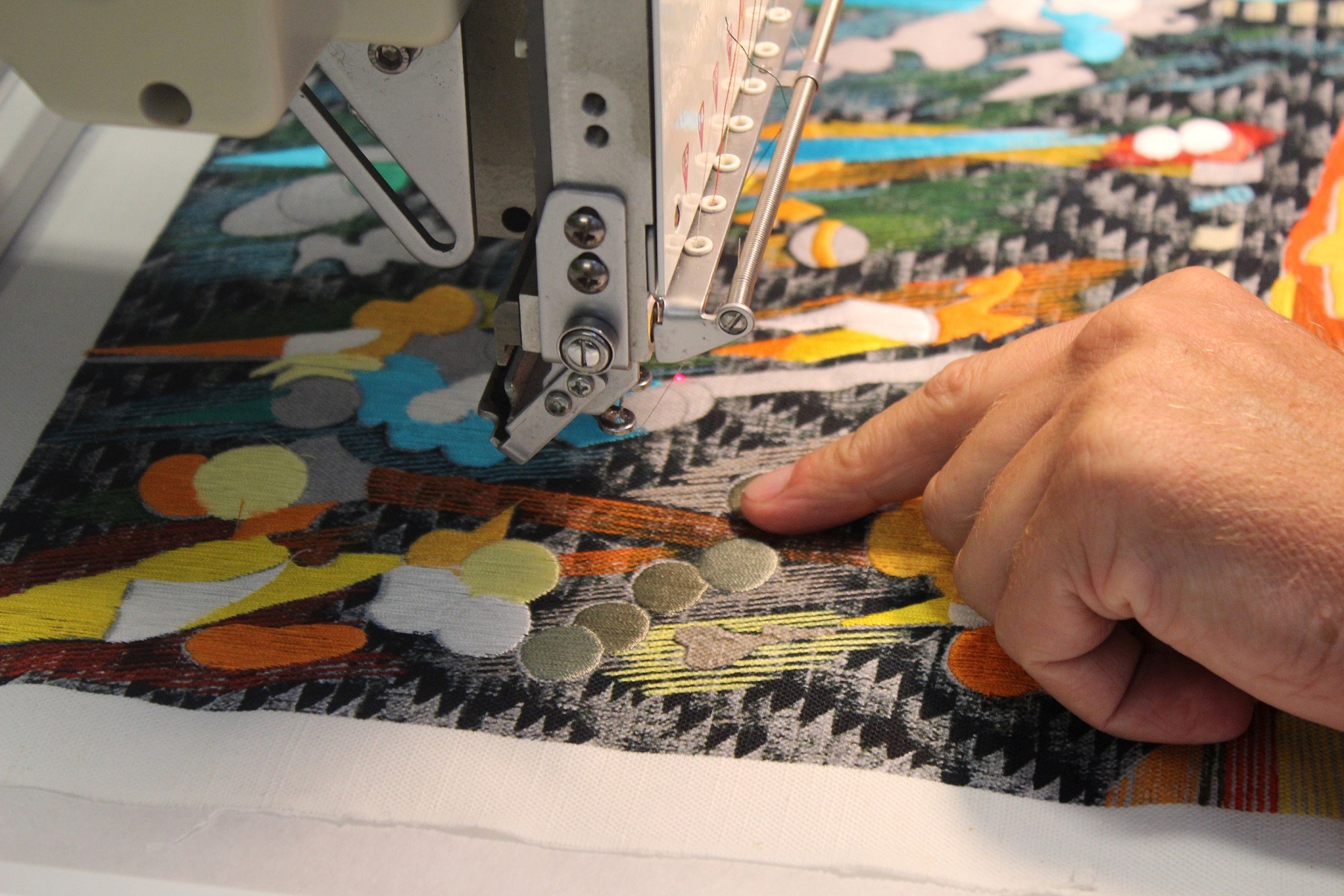
A systematic approach
Was there any other preparatory work?
As part of the preparation, I had to find a design that suited the style of the embroiderers’ textile art. Once that was identified, everyone got the same design to embroider.
Moreover, it was important for the research that everyone adhered to a strict assignment brief. This meant that each artist used the same embroidery stitch, embroidery direction and use of colour. In short, each was to embroider in the same way in order to keep the assignment as simple as possible.
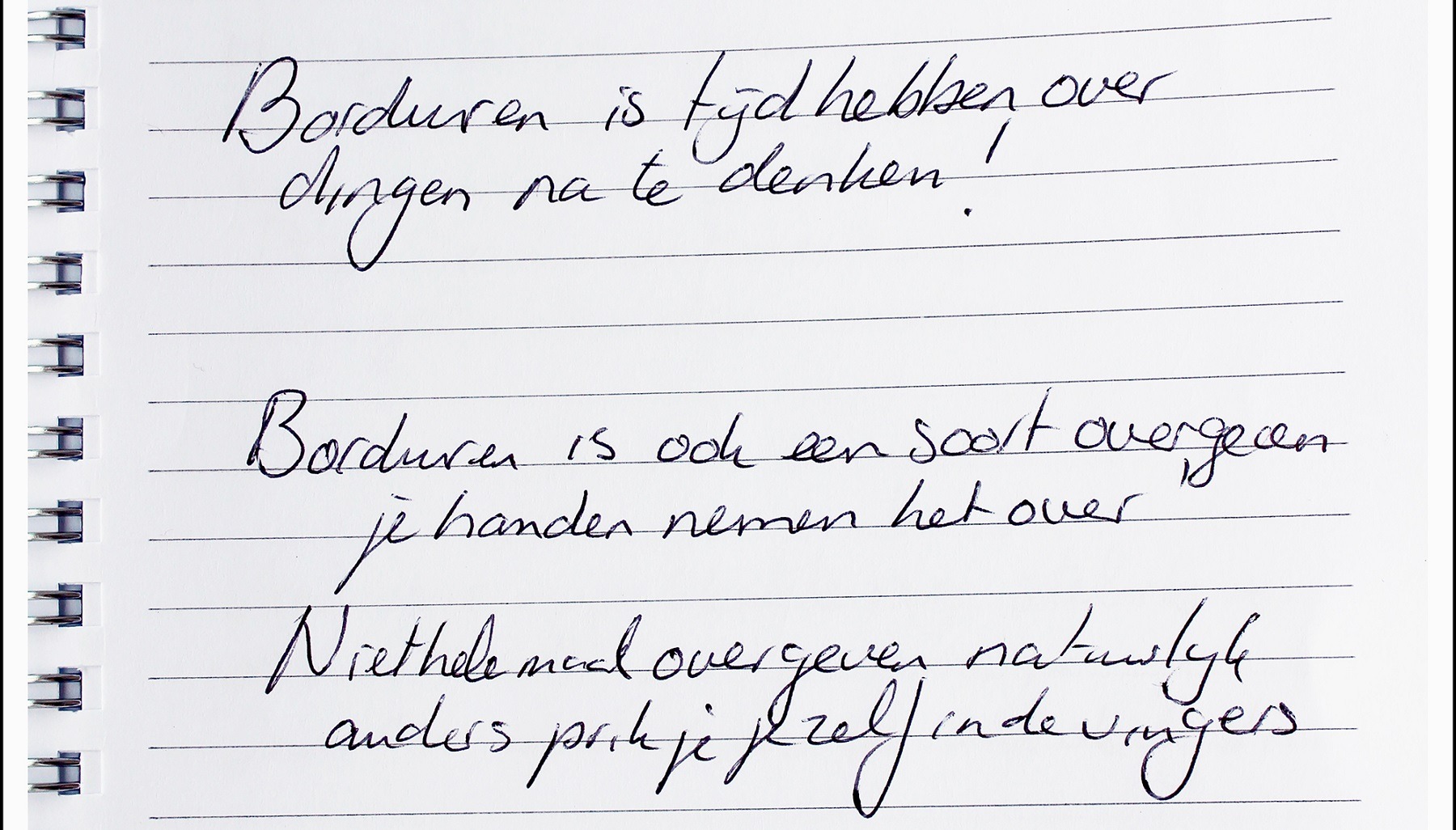
What materials were used in the creation of the piece? How did you select them? Where did you source them?
In the sample, I used the same materials as I always do: DMC yarn and acrylic on raw linen.
However, to copy the design for the other four artists, I hired a photographer to make a professional photo of the sample. House of U (Someren, Netherlands) printed the photo on CO linen Nora. The artists received an embroidery kit containing the colour scheme, DMC yarn, one print of the design and the instructions.
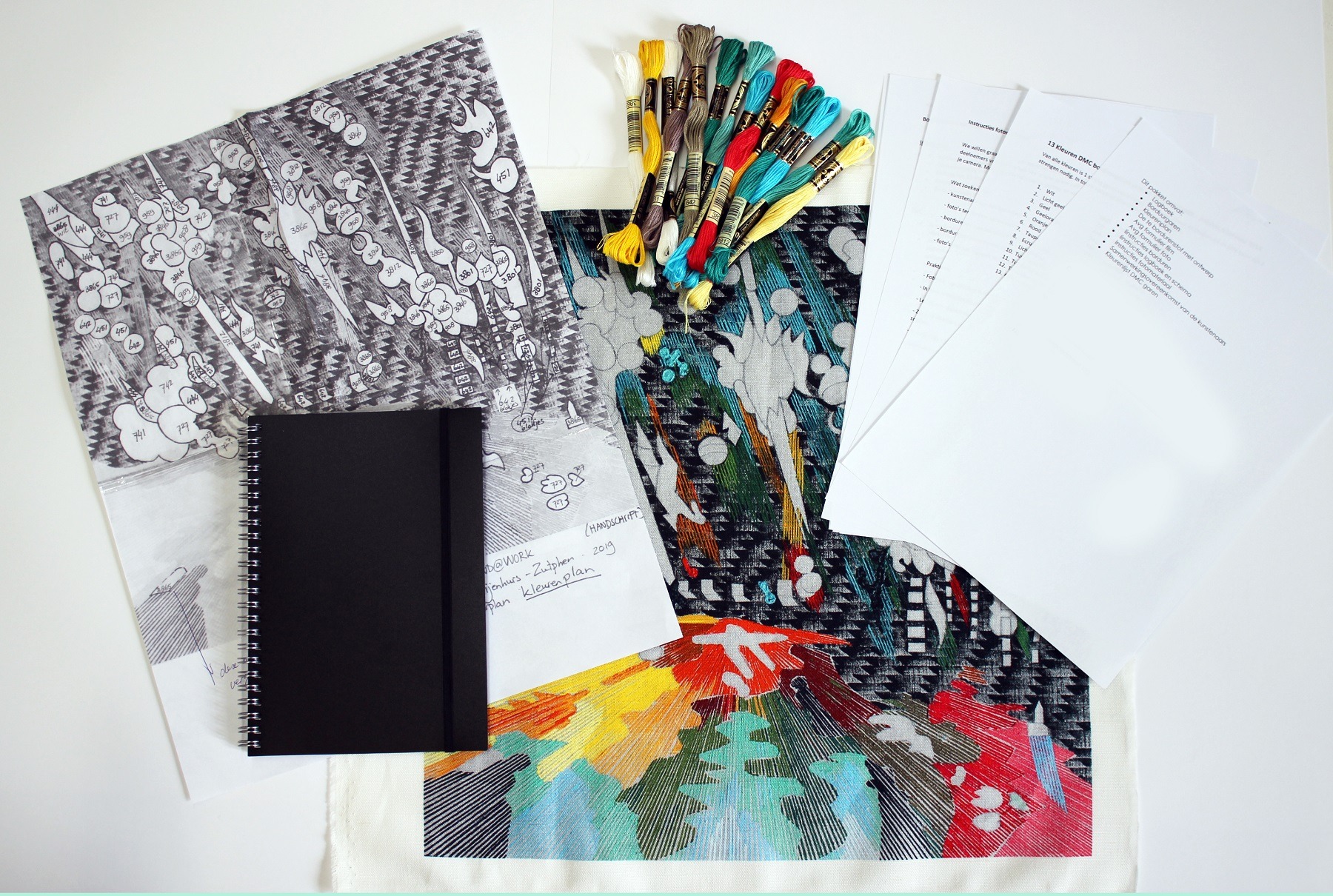
What equipment did you use in the creation of the piece and how was it used?
The participating artists, including myself, used a needle, DMC yarn, scissors, embroidery ring, logbook and a photographic camera.
The embroidery machine used at TextileLab was an SWF model and used a yarn made of Gunold embroidery thread, which is polyester and viscose rayon.
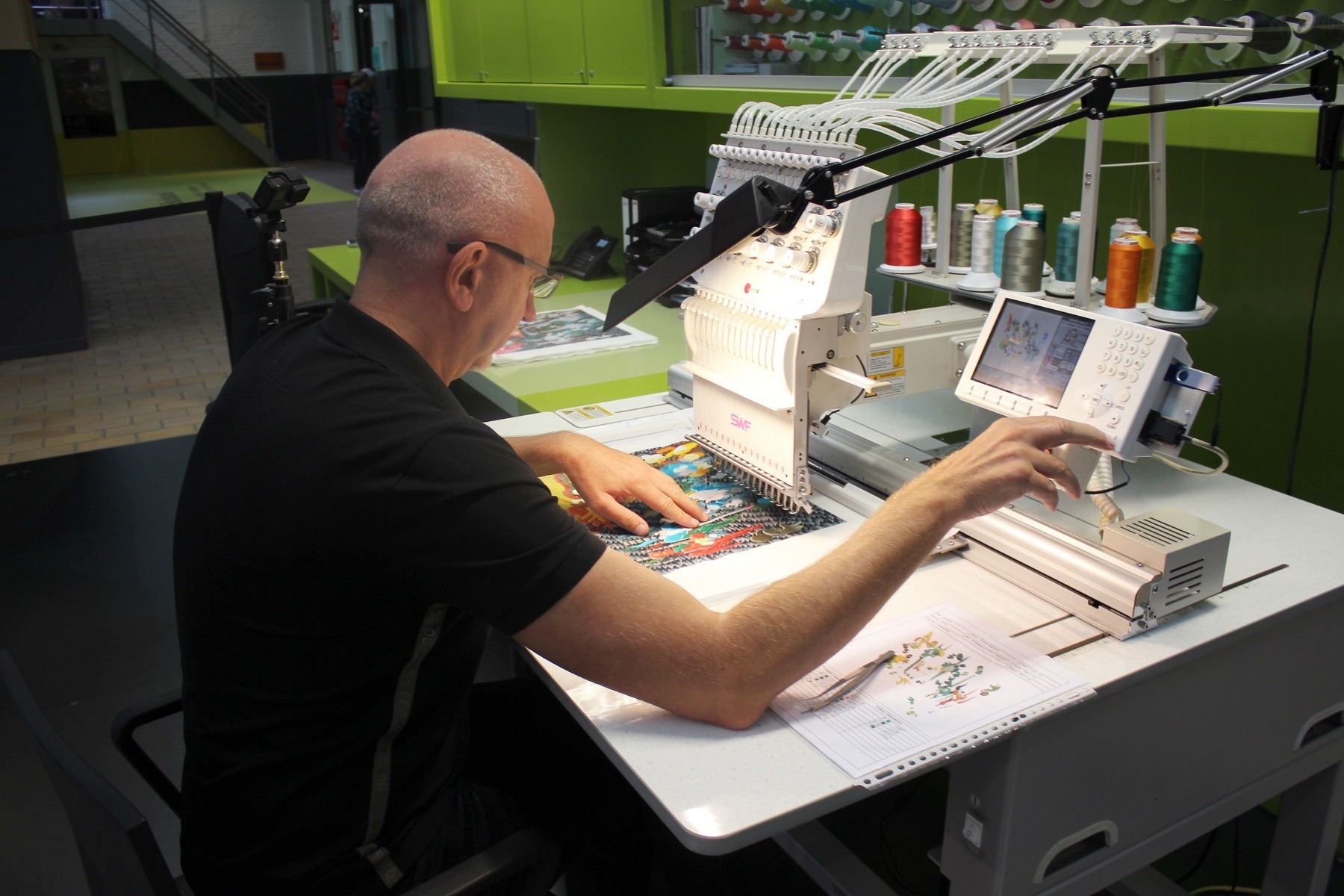
A sense of individuality
Take us through the creation of the piece stage by stage
In the summer of 2019, the embroidering artists received my design and their logbooks and started embroidering. They shared their experiences in their logs, in a WhatsApp group and in photos. Writing about their experiences and thoughts during the project made them more conscious of what happened to them during the act of embroidering. But how did the artists experience the process?
Tessa van Helden: “In the beginning, I had to get used to the vertical embroidery stitch. And I felt a bit uncomfortable to embroider a pattern that had been designed beforehand. Normally I work much more freely and I make choices during the process.”
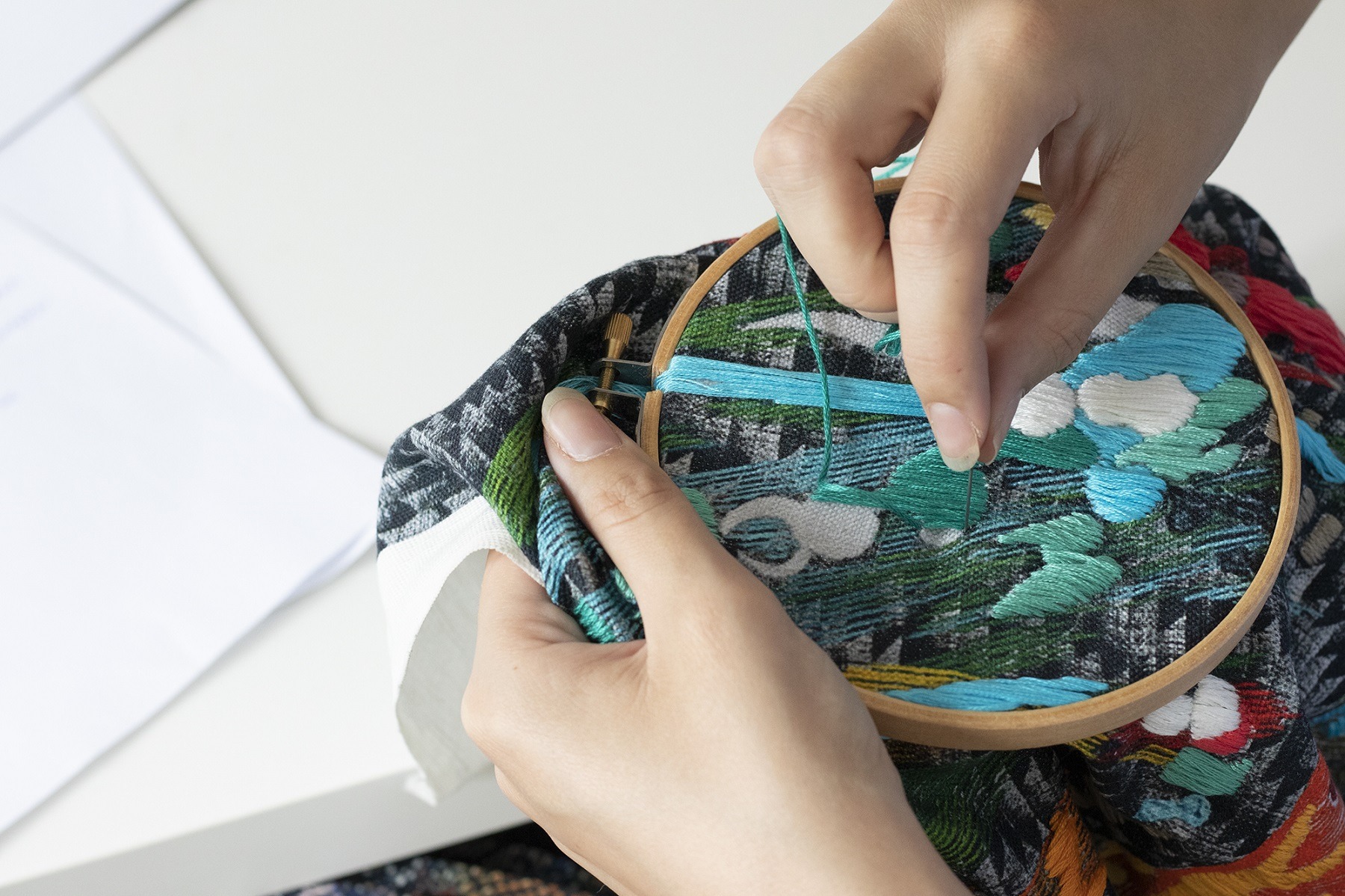
Hinke Schreuders wrote in her logbook about this project: “I am sitting on the floor, in a bright room. The door to the garden opens and I hear the rustle of the wind in the large poplar outside. In the centre of the busy city, it is quiet and peaceful.”
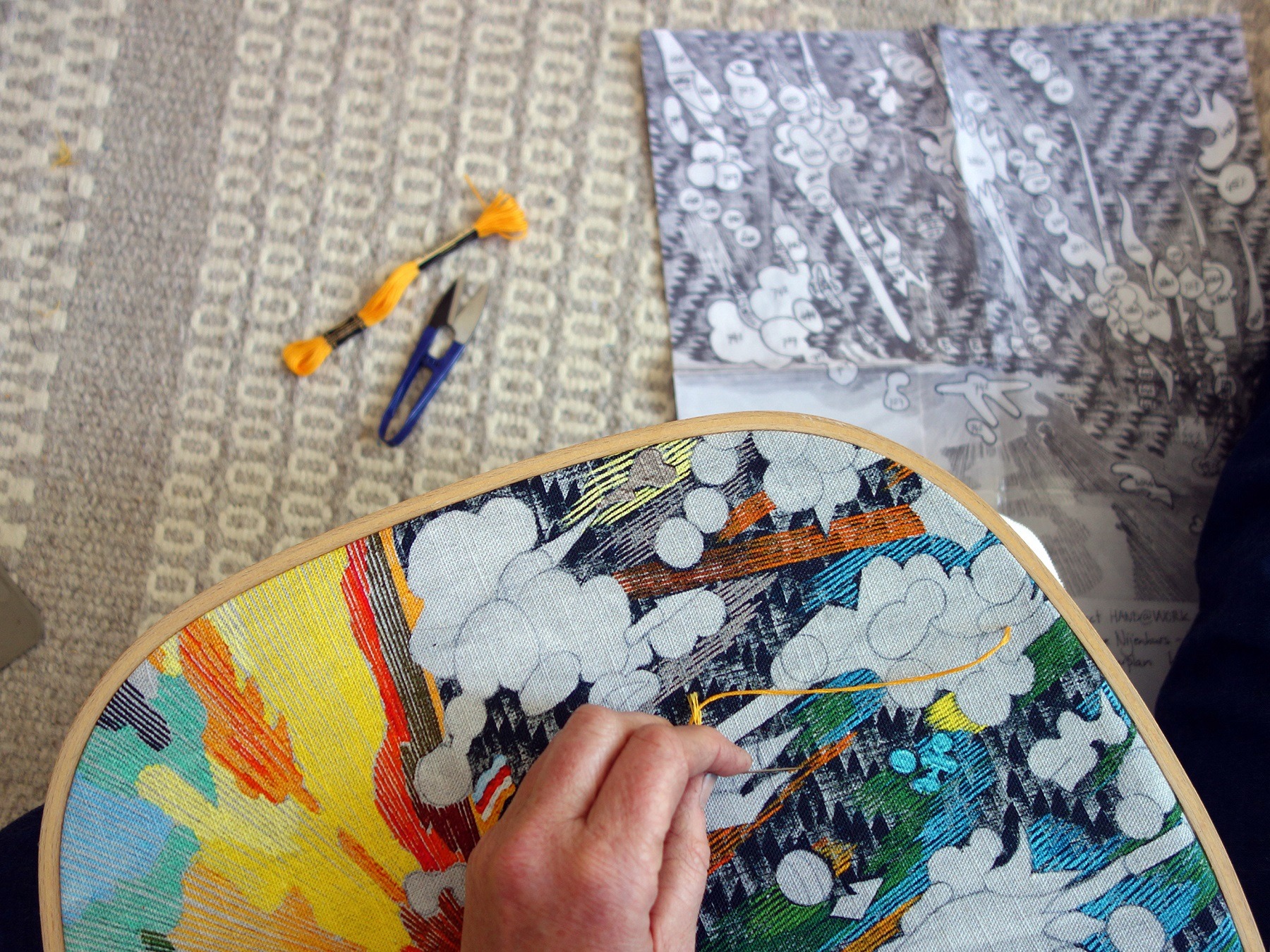
Mique Menheere too enjoys the zen feeling she gets whilst embroidering. “To me, embroidering gives me more room for free thoughts than whilst working on the computer.”
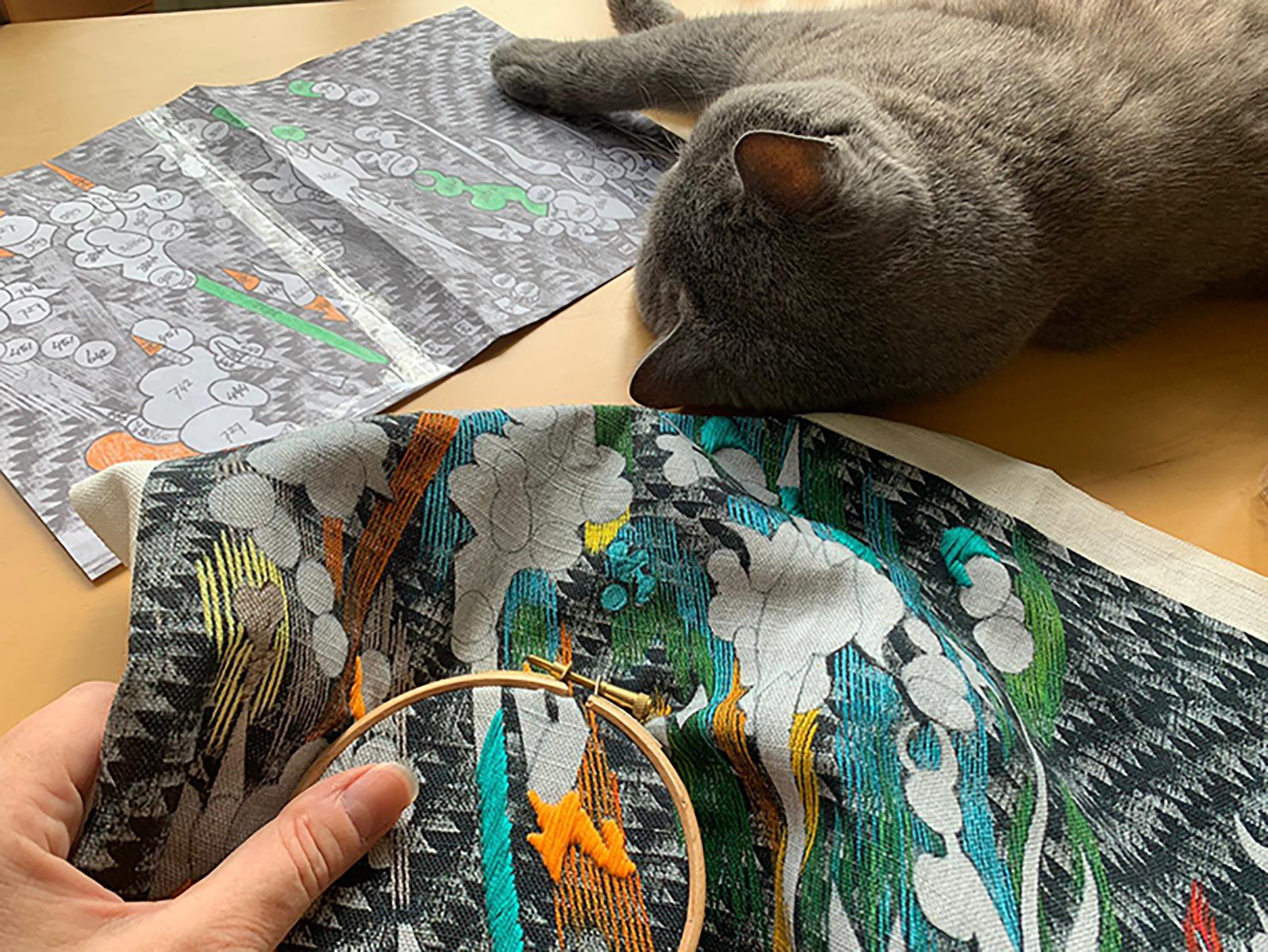
Marjolein Burbank took her homework for this project to Bolivia and discussed it with the local people whilst embroidering in the park. “In the beginning it was frustrating because I noticed that I could no longer see as well as I used to. This was until I reached an acceptance that it would not be as beautiful as I wanted. After that, it became very pleasant. The result of the embroidery from each of us is different. From this I conclude that I must have put something of my own into the embroidery.”
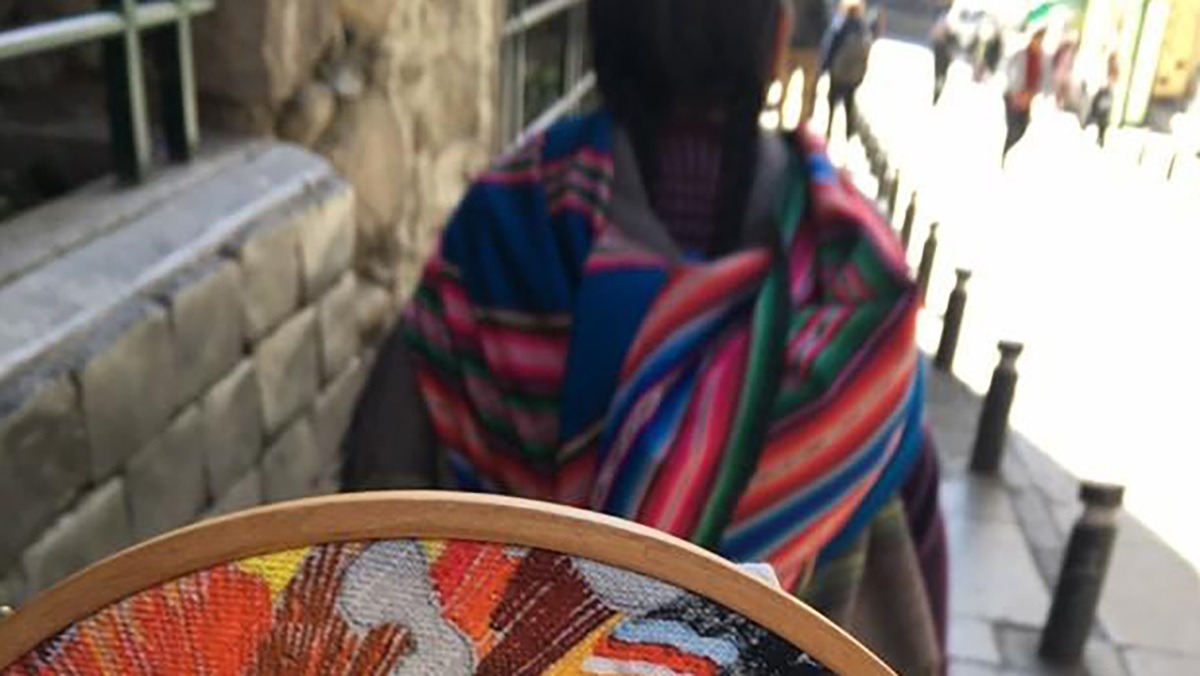
Mique Menheere added: “In this project I found it to be quite a challenge to work according to someone else’s method. Initially, procrastination was lurking. After a week of embroidering, I enjoyed it more and more. My motivation is the battle and our research questions; I am so curious about the result.”
Myself, Pauline Nijenhuis: “In the beginning, I noticed that I wanted to embroider more neatly because there were also four other ladies embroidering this design. And, of course, the embroidery machine! Fortunately, I was able to get over this and to be true to myself. That’s what it’s all about in this project. Handwriting in embroidery says something about yourself. And if I work more neatly, it won’t be me!!!!
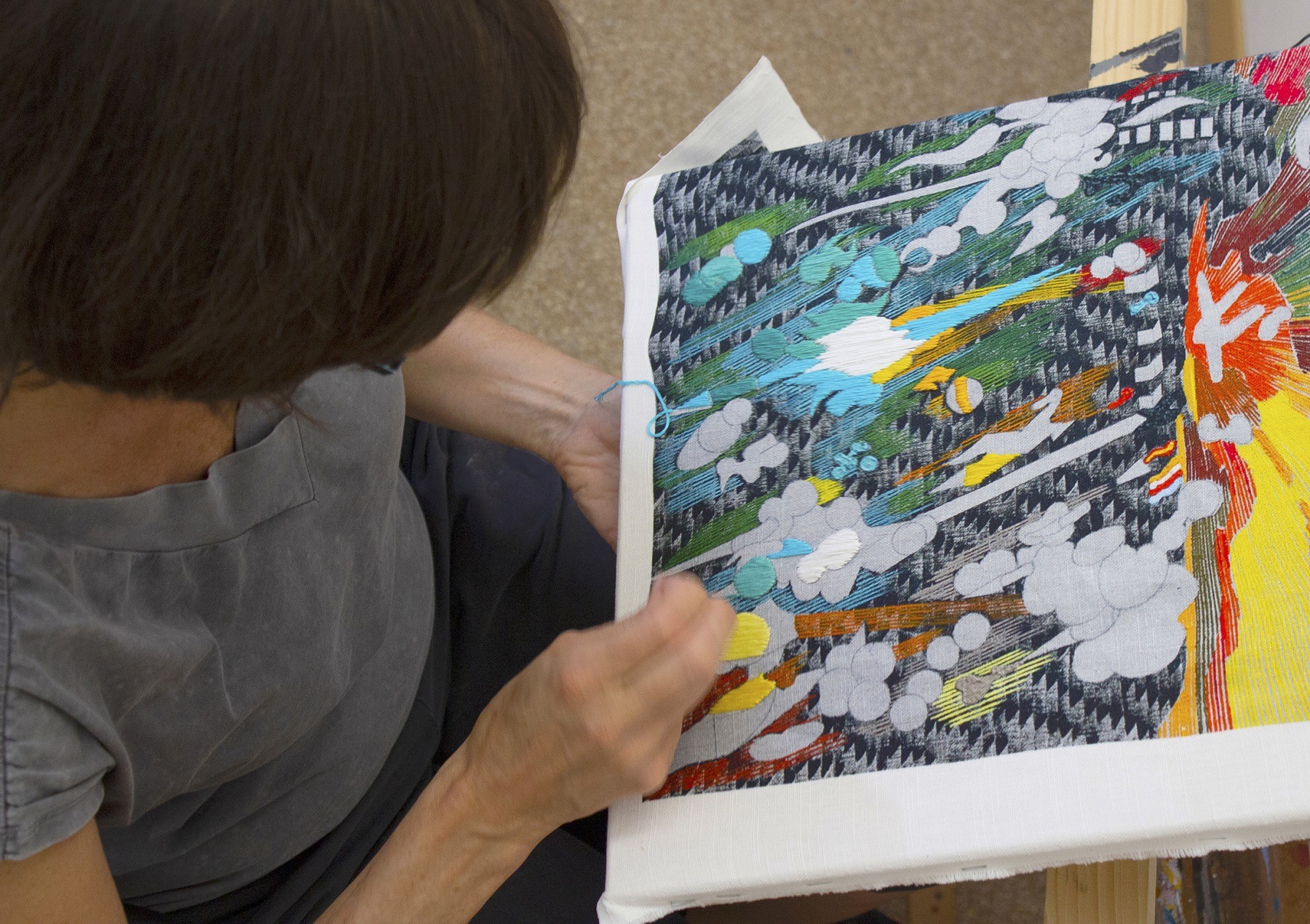
Meanwhile, the embroidery machine at the TextileLab in Tilburg embroidered the same design. Frank de Wind programmed my design. As Frank worked, it soon became apparent that adjustments were needed to get as close as possible to the hand embroidery. Other yarns are used in the machine and the machine stitch could not be longer than 3 cm. For each colour, a new sequence of embroidering had to be started on the machine. In total there were 13 colours. In this design, it was difficult for the machine to choose the starting point of the next shape that had to be filled. So, if you look closely, you can see in the machine embroidery that it resulted in the forms not being fully or correctly filled.
The machine makes 550 stitches per minute. and a total of 22,875 3 cm stitches were required. Embroidering one piece of this work took 40 minutes. On the other hand, the hand embroiderers took an average of about 13 hours.
You can see further close up images of each artist’s finished pieces on Pauline’s website here
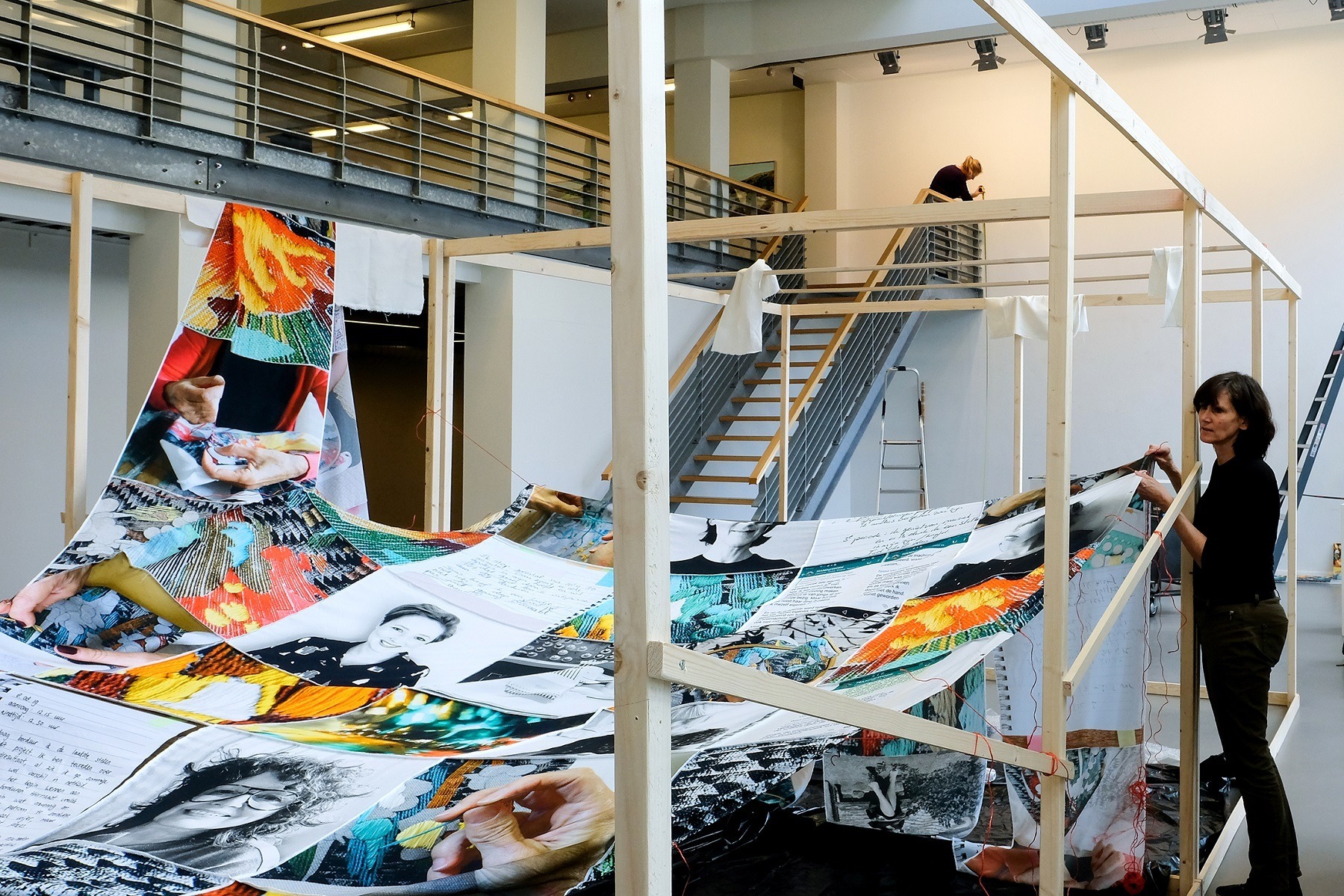
What journey has the piece been on since its creation?
The HAND@WORK project is wrapped up in a multidisciplinary installation: the five embroidery works by the participating artists, six machine embroidered works, a film documentary (12 minutes), a large object called ‘Under Construction’ (see photos) and a digital survey among visitors.
I want to find out from this project the visitors’ opinions about manufacturing by hand or machine – in this case about embroidery. So part of the exhibition included a digital survey questioning them about this. I also asked visitors about their appreciation of handicrafts.
Once the results are analysed, I will write a book with Caroline about this project and our conclusions.
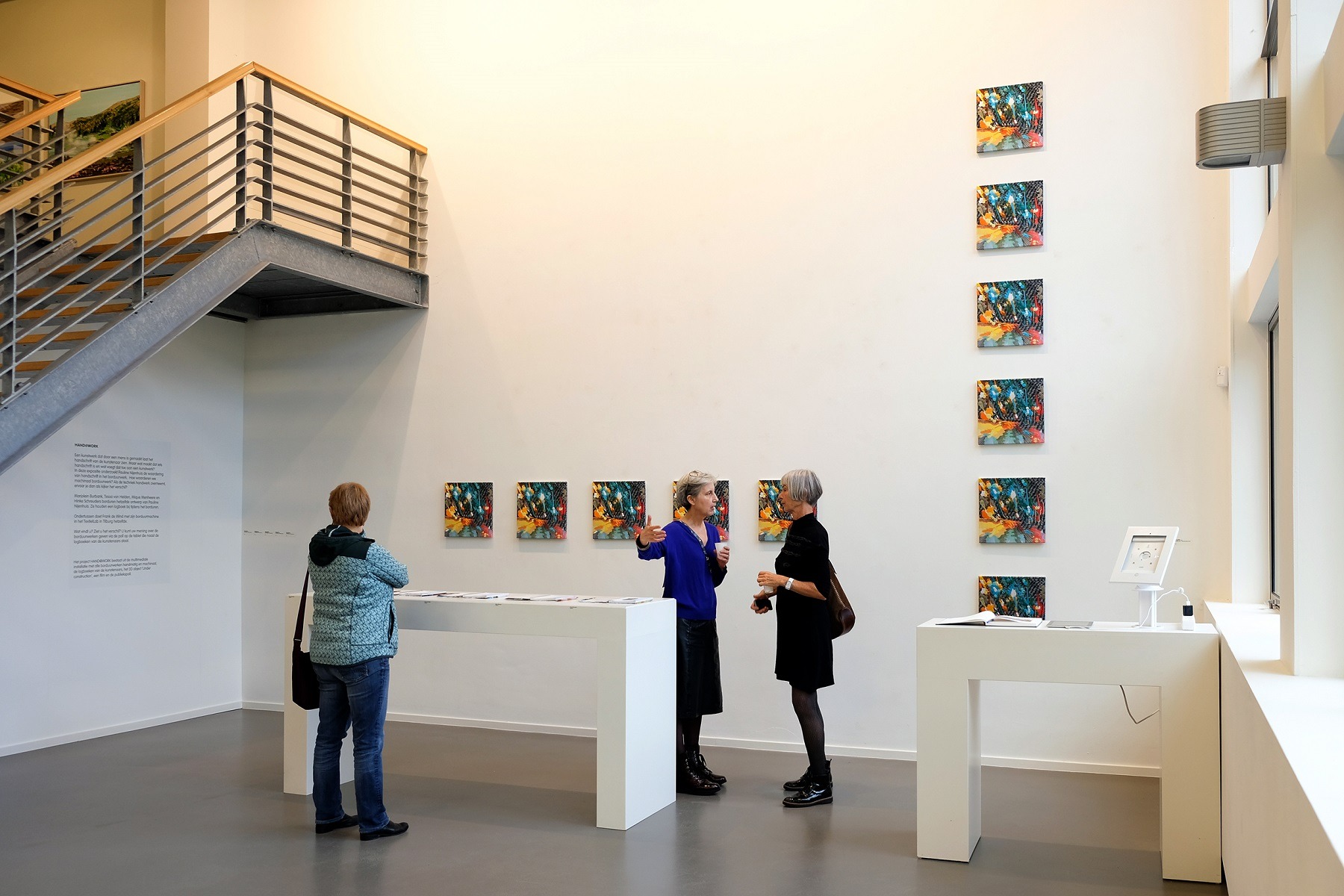
The installation of this HAND@WORK project ran from October 2019 until January 2020 at the Fabric, CBK Emmen, Netherlands, and included almost all my work in a solo exhibition.
From 15 March till 3 May 2020 this project can also be seen at another solo exhibition in Dat Bolwerck, a beautiful centre for exhibitions, concerts, philosophy meetings, lectures and workshops in Zutphen, Netherlands, which also happens to be near my workshop.
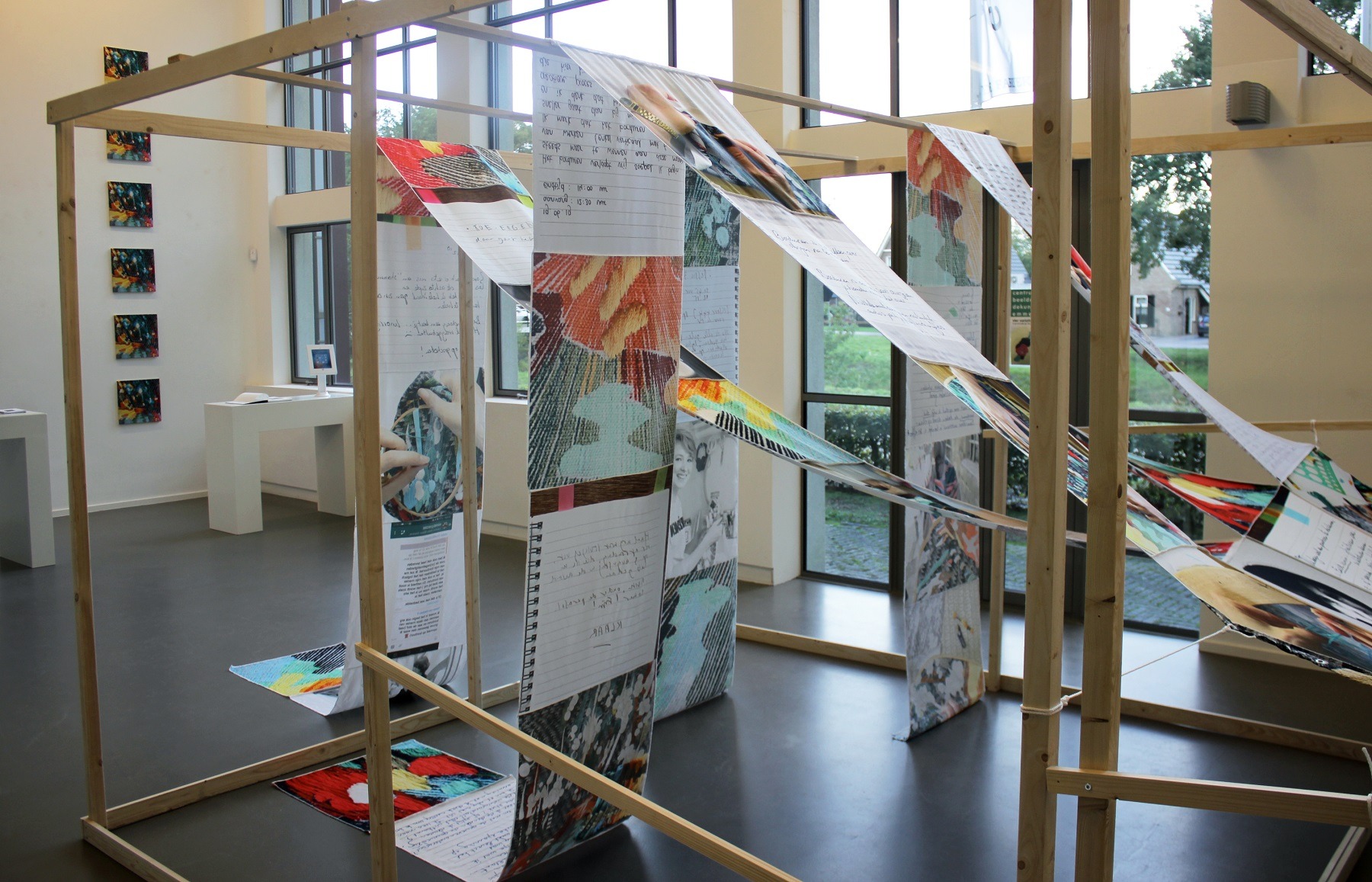
For more information visit www.paulinenijenhuis.com
We’d love to know your thoughts and comments about Pauline’s project. Please leave a comment in the section below
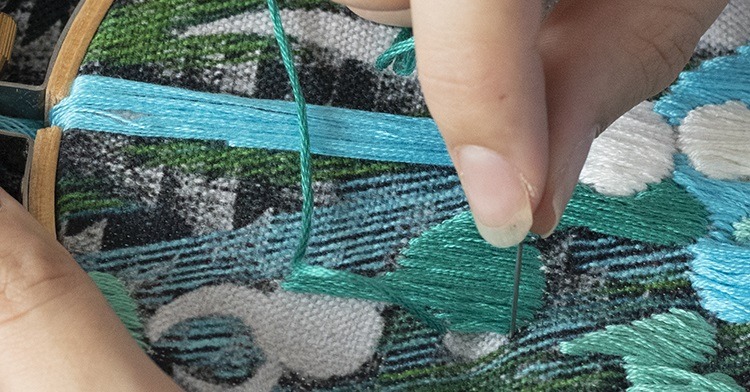

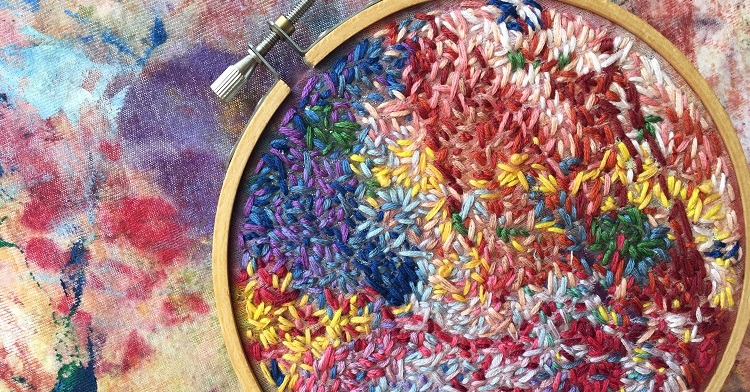
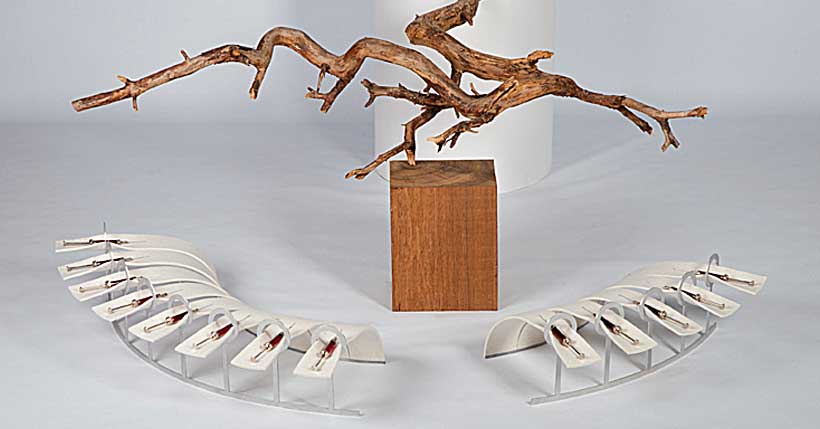
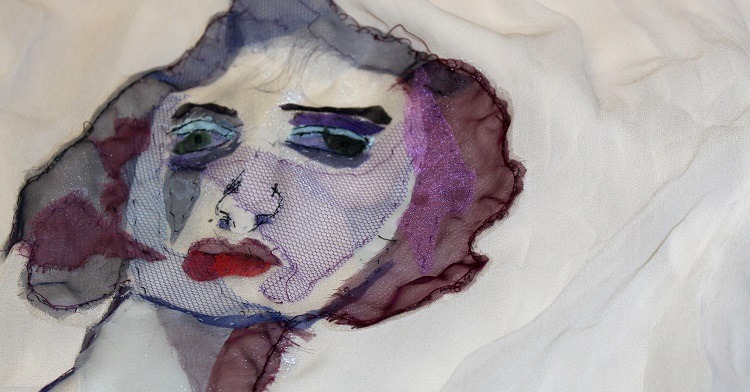
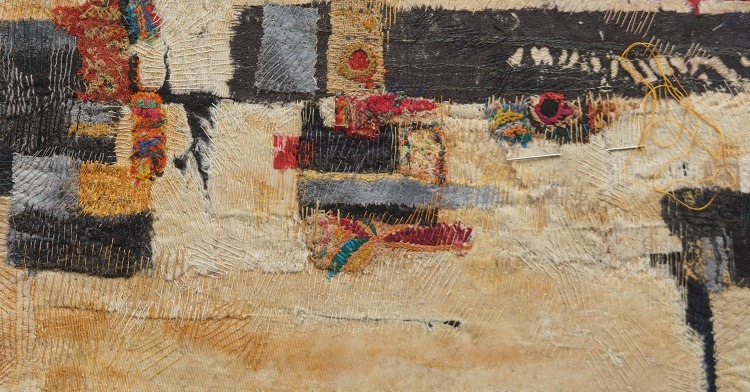
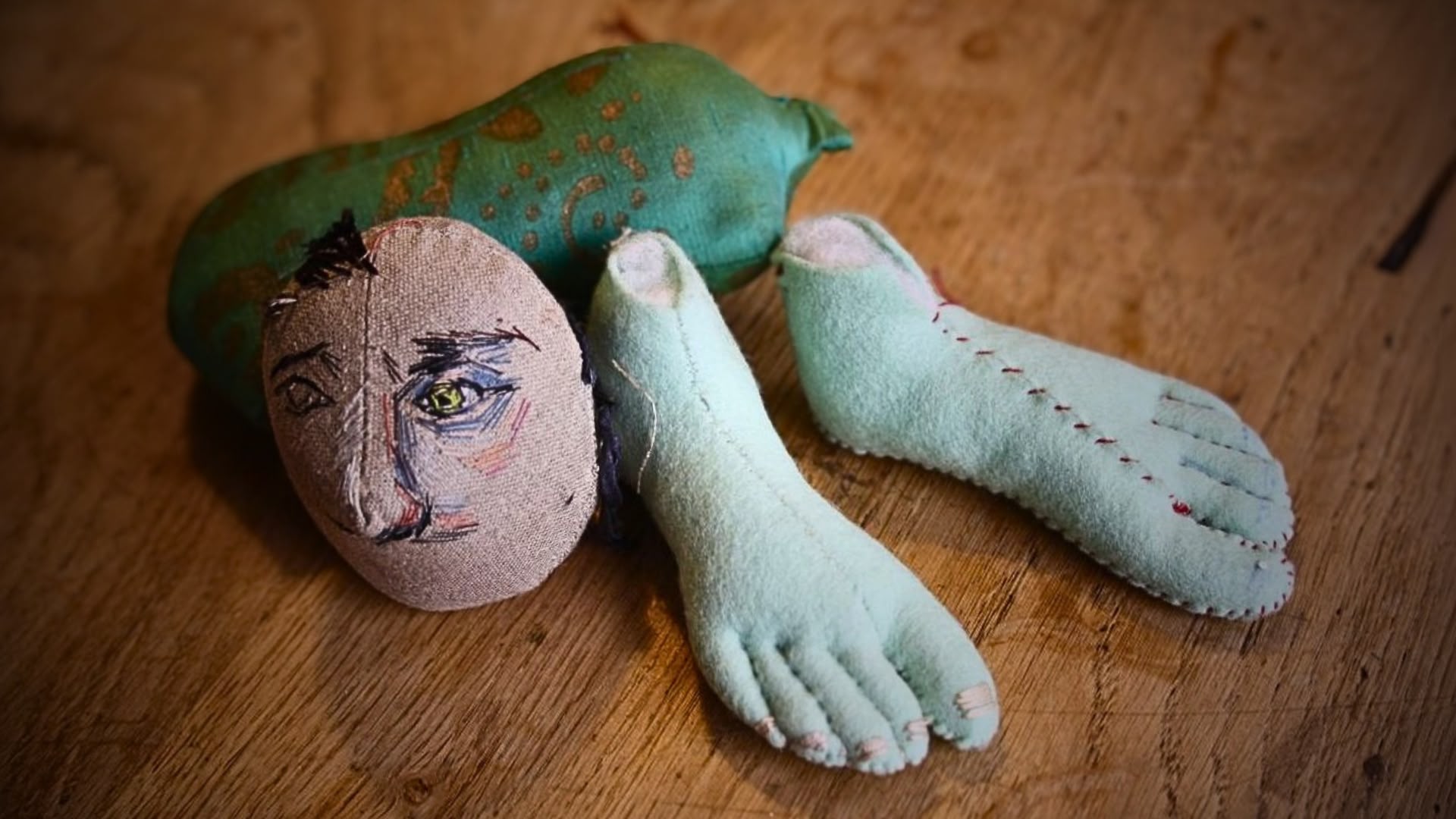
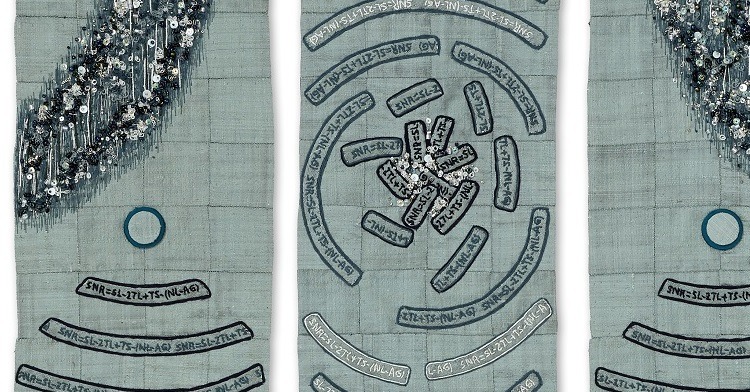
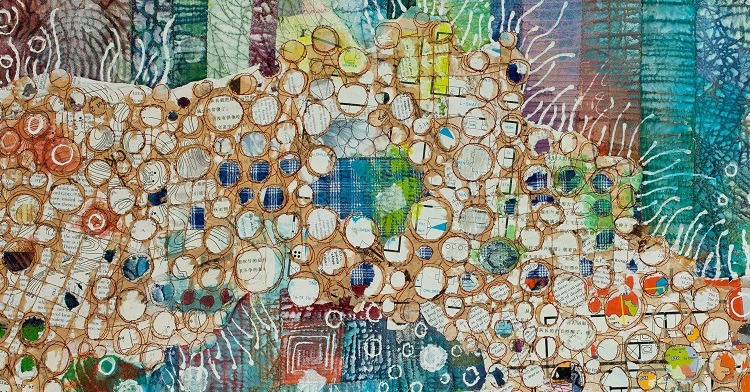
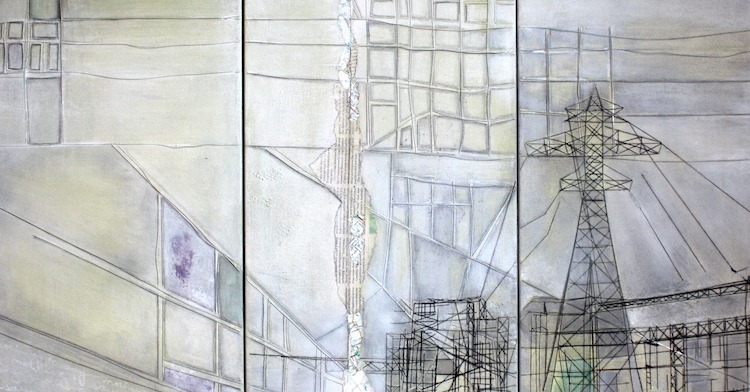
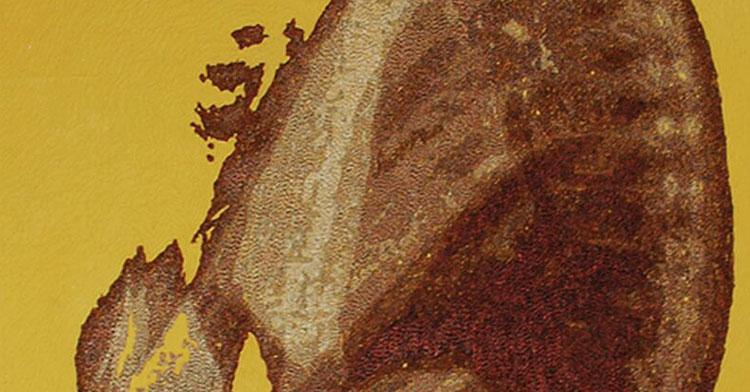
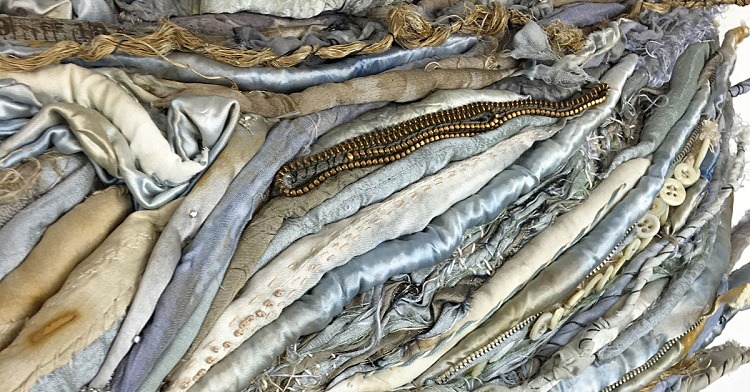
19 comments
jane lavender
A really important project . It is a subject I have been looking at for several years .
The conclusion I come to that we see ourselves in things we make .( A record of the shape of the body /hand movement , rhythm, time and thought ) but also I think in the hand made the presence of others can be sensed ( and so one is not alone ) .
Regina Dunn
What a fantastic project. I have a science background and love to design experiments and analyze results. As an artist, I prefer to see handwork instead of machine work. I, too, wonder what the general public prefers or if they care one way or the other. And I love imperfections. They tell interesting stories and create subjects to ponder.
Pauline Nijenhuis
Hi Regina, Thanks Regina. And I am fully agree with you. The poll of my project at the exhibition is very interesting also the written answeres about my questions. But I think my public at the exhibition is not an average one. The visitors who come are interested in art and I think is pecialy in textile art / crafts. So it would be nice when I can test this on an avarage audience.
veronica aldous
I am starting to combine machine work and hand stitch to create a tangible discourse between the two mediums, neither of which seem fully appreciated as Fine Art. Using images of women I create a shadowy machine painting using layers and then apply hand stitch around and about. I am working on a theme of Lost Gardens addressing what it means to be a woman in a time of turbulent anxieties, about loss and memory and the terrible consequences of Climate Change on Nature and us as humans who love and adore the natural world.Some of this development can be seen on my Instagram page.I think I need to use machines to help me underpin and get down my ideas fast but the hand stitch element harks back to traditional women’s handicraft occupations, to embellishment and to fashion.
Pauline Nijenhuis
Interesting what you are doing.
I saw your work on Instagram and follow you.
I think we should think about when we use machines?.
But most off all to think about the reason why we have machines? Which values we assign to productivity in speed and quality. And what is quality? Is quality perfection?
Pat Cave
I would be interested to see how the stitches change as the mood and circumstances of each embroiderer stitched or if it didn’t…how consistent the work is in each piece and which part of the work took them back to a particular time. I guess a time line would need to be created – I expect that would be the diary – how would you display this?
Charlotte Tefft
To have a question, to create a way to visually answer the question and then to do it, is AMAZING. I have found embroidery very calming and heart healing, even when my hands and mind get pierced by the needle. So worth the journey. Oh how I wish I could see these with my very own eyes. Rolling the computer images up and down is a bit unsatisfying. Two hours eye to art would be JOY.
Pauline Nijenhuis
Thanks. And I fully agree with you of the benefits of embroidery on body and mind.
Marilyn Clulow
I loved the hand stitched pieces, you can see the hand that made it, the hand embroidered pieces had texture and life, the machine was flat and lifeless. No comparison. I find hand embroidery so soul satisfying. I can’t imagine programming a machine to do the work , that just makes you a technologist and anyone can do that.Give me handwork anytime!
Michelle Dickson
I love your ideas to explore this further.
Pauline Nijenhuis
Dear Joyce, that will be an other research more about creativity. I was searching for signature in the most minimalistic way. And the signature of the machine. and what does embroidery with us, the maker. But also to the spectator. I want to lets us think about the future, do we want to take over all our tasks.
In a new project I’m going to explore something else, where creativity plays a role.
Thanks for thinking with me!
Pauline Nijenhuis
Thanks Marilyn, till now 85% off the poll about this project thinks the same as you.
Regards Pauline
Joyce Spurr
Very interesting concept, giving artists such controlled parimeters and yet being able to distinguish the differences in their works.
It would be interesting to again give the same artists the same stamped piece, the same colors and materials (similar to paint-by-number) and no other rules to see the difference when allowed to choose their own stitch styles.
Now, give them the pattern and same materials and allow them to choose where the colors will be used. They must use some of each item.
Next, give them the the same stamped piece with no other restrictions. Allow them to use their own materials and color. Their only restriction is to follow the pattern.
And finally, send them a paper copy of the design and have size as their only restriction, allowing them to re-create the design freestyle, to see their own interpretation of the design.
It would be interesting to compare all six artists at each step horizontally and their individual style changes vertically.
Sandra
What an interesting article. I am always thinking about the time consuming with hand embroidery, but don’t feel fully happy with the machine embroidery work. I will follow the project to see how it goes.
Pauline Nijenhuis
Thanks for your interest, Sandra In April 19th I will publishe a book about this project, in Dutch and English. With also the reactions/ comments from the visitors during the exhibition of this project.
cheryl wilson smith
really interested in this project as it applies to so many of us.
Pauline Nijenhuis
Thank you Cheryl!
Pam Buck
Really interesting project, but I did wonder about the time of 40 mins given for the machine embroidery, did it or should it also include the time for programming the machine? Personally, I love the individuality of hand stitching just as in handwriting, but machine embroidery also has a place and beauty of its own!
Pauline Nijenhuis
Thank you Pam. And the embroiderers needed an average of 14 hours to finish. The embroidery machine was able to embroider 6 works in the same time (with preparation time).